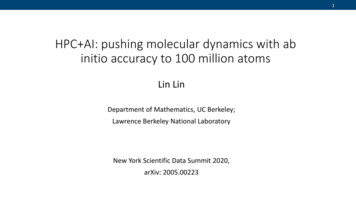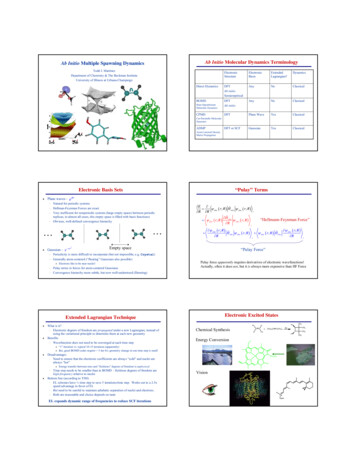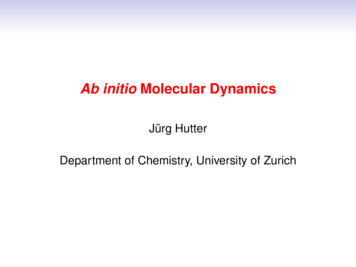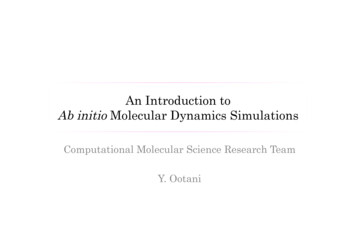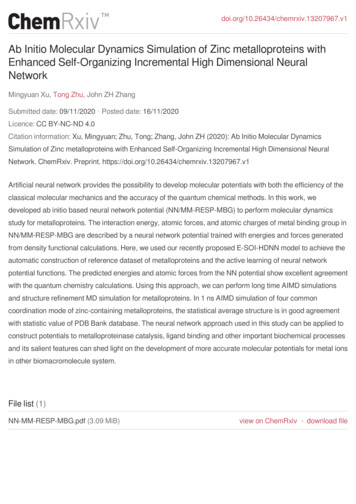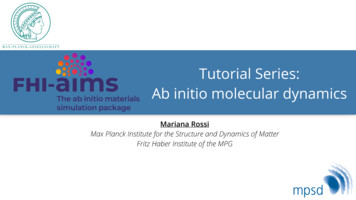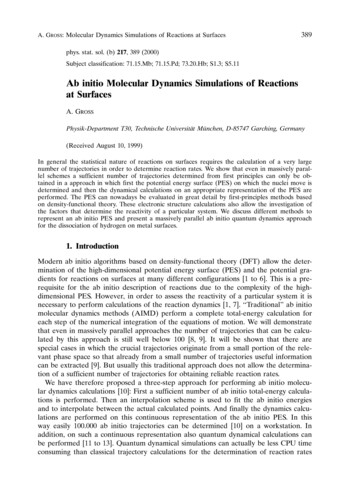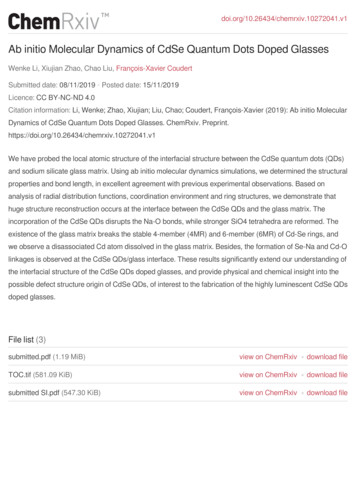
Transcription
doi.org/10.26434/chemrxiv.10272041.v1Ab initio Molecular Dynamics of CdSe Quantum Dots Doped GlassesWenke Li, Xiujian Zhao, Chao Liu, François-Xavier CoudertSubmitted date: 08/11/2019 Posted date: 15/11/2019Licence: CC BY-NC-ND 4.0Citation information: Li, Wenke; Zhao, Xiujian; Liu, Chao; Coudert, François-Xavier (2019): Ab initio MolecularDynamics of CdSe Quantum Dots Doped Glasses. ChemRxiv. 1.v1We have probed the local atomic structure of the interfacial structure between the CdSe quantum dots (QDs)and sodium silicate glass matrix. Using ab initio molecular dynamics simulations, we determined the structuralproperties and bond length, in excellent agreement with previous experimental observations. Based onanalysis of radial distribution functions, coordination environment and ring structures, we demonstrate thathuge structure reconstruction occurs at the interface between the CdSe QDs and the glass matrix. Theincorporation of the CdSe QDs disrupts the Na-O bonds, while stronger SiO4 tetrahedra are reformed. Theexistence of the glass matrix breaks the stable 4-member (4MR) and 6-member (6MR) of Cd-Se rings, andwe observe a disassociated Cd atom dissolved in the glass matrix. Besides, the formation of Se-Na and Cd-Olinkages is observed at the CdSe QDs/glass interface. These results significantly extend our understanding ofthe interfacial structure of the CdSe QDs doped glasses, and provide physical and chemical insight into thepossible defect structure origin of CdSe QDs, of interest to the fabrication of the highly luminescent CdSe QDsdoped glasses.File list (3)submitted.pdf (1.19 MiB)view on ChemRxivdownload fileTOC.tif (581.09 KiB)view on ChemRxivdownload filesubmitted SI.pdf (547.30 KiB)view on ChemRxivdownload file
Ab initio molecular dynamics of CdSe Quantum Dots Doped GlassesWenke Li,1,2 Xiujian Zhao,1 Chao Liu,1* François-Xavier Coudert2*1State Key Laboratory of Silicate Materials for Architectures, Wuhan University ofTechnology, Hubei, 430070, China2Chimie ParisTech, PSL University, CNRS, Institut de Recherche de Chimie Paris,75005 Paris, FranceAbstract: We have probed the local atomic structure of the interfacial structure betweenthe CdSe quantum dots (QDs) and sodium silicate glass matrix. Using ab initiomolecular dynamics simulations, we determined the structural properties and bondlength, in excellent agreement with previous experimental observations. Based onanalysis of radial distribution functions, coordination environment and ring structures,we demonstrate that huge structure reconstruction occurs at the interface between theCdSe QDs and the glass matrix. The incorporation of the CdSe QDs disrupts the Na-Obonds, while stronger SiO4 tetrahedra are reformed. The existence of the glass matrixbreaks the stable 4-member (4MR) and 6-member (6MR) of Cd-Se rings, and weobserve a disassociated Cd atom dissolved in the glass matrix. Besides, the formationof Se-Na and Cd-O linkages is observed at the CdSe QDs/glass interface. These resultssignificantly extend our understanding of the interfacial structure of the CdSe QDsdoped glasses, and provide physical and chemical insight into the possible defectstructure origin of CdSe QDs, of interest to the fabrication of the highly luminescentCdSe QDs doped glasses.1. IntroductionThe tunable optical properties and electronic properties of quantum dots induced byquantum confinement have stimulated enormous research interest. These propertieswere extensively explored for applications in the fields of lasers,1 light-emittingdiodes(LEDs)2 and bio-labeling.3 Colloidal quantum dots exhibit excellentluminescence properties, however, agglomeration of these QDs in solution severelyrestricts their practical applications. As an alternative, quantum dots doped glassescombine the good thermal and chemical stability of glass together with easy access todevice fabrication, hence offering potential applications in non-linear optical devices4and LEDs.5However, the main problem when CdSe quantum dots are embedded into glasses is thatthe presence of defects at the interface between QDs and glass matrix can quench theexcitonic emission and produce unfavorable defect emission, which hinders theapplications.6 Consequently, it is of great importance to have a thorough understandingof the local atomic structure of CdSe quantum dots doped glasses and the origin of the
defects. Currently, it is experimentally challenging to characterize the structure andchemical environment of CdSe quantum dots doped glass due to the inadequateresolution of the existing techniques, the instability of glass matrix under electronicbeam, and the relatively low concentration of QDs in glass, and the encapsulation ofquantum dots by the glass matrix. Theoretical modelling has been applied as analternative to bring insight into these issues, and a comprehensive exploration of thelocal atomic structure can give guidance to the design of highly luminescent glasses.Computational materials studies have become very popular due to increasingcomputational power and the development of efficient numerical algorithms, and caninvestigate a system at the atomistic level which is not directly possible in experiments,gaining insight into both physical and chemical properties of materials. The two maincomputational methods for materials are classical approaches and ab initio simulations.Both classical molecular dynamics (MD) and the ab initio molecular dynamics (AIMD)were successfully used in modelling various multicomponent glass materials withdifferent size7-13 and CdSe nanocrystals.14-20 However, in spite of these extensivetheoretical studies for these two separate systems, no atomistic calculations have beenconducted so far on the composite QD/glass systems and their interfacial properties.In this work, we have employed ab initio molecular dynamics in order to model CdSequantum dots embedded in a glass matrix, with a particular focus on the reconstructionoccurring at the QD/glass interface. We started from classical MD calculations of theglass matrix, and quantum chemical models of the quantum dots. Because theinteraction between the CdSe QDs and glass matrix cannot be described accurately inclassical MD due to the lack of the appropriate interatomic potentials, we used ab initiomethods. Our ab initio MD methodology is based on quantum mechanics at densityfunctional theory (DFT) level, which means it does not rely on a fixed functional formfor interatomic interactions, but the electronic degrees of freedom of each atom are fullymodelled. Due to the limitation of computational power cost, we chose a model of thecomposite system with the composition of 60Na2O-120SiO2-33CdSe to conduct theAIMD simulations. The radial distribution functions for Si-O, Na-O, Cd-Se, Cd-O, SeNa, Se-Se and Cd-Cd were calculated to compare with experimental values. Thecoordination environment and the rings structures were analyzed. The resultsdemonstrates that enormous structure reconstruction happens simultaneously in QDsand glass matrix, with creation of Cd-O bonds and Se-Na bonds at the interface. Theincorporation of the CdSe QDs disrupts Na-O bonds, while stronger SiO4 tetrahedra arereformed. The glass matrix contributes to great structure reconstruction at the externalsurface of the quantum dot, making it hard to maintain the bulk structure even at itscore. The results reported here can give a better fundamental understanding of thiscomplex system, and giving insight for the fabrication of highly luminescent glassescontaining quantum dots.2. Computational methods2.1 Generation of glass matrix structureThe starting configuration for the glass matrix were generated by placing atoms
randomly in a cubic simulation box. The total number of atoms for the glass was540(120 Na, 120 Si, and 300 O), with the simulation cell sizes (a b c 19.383 Å,α β γ 90 ) kept constant throughout the simulation, giving the density consistentwith experimental values (r 2.492 g/cm3).12 Hard constraints were imposed to avoidunphysically small interatomic distances. An initial classical molecular dynamicssimulation was performed using a partial-charge rigid-ion pairwise potential developedby Pedone et al.,13 with the DL POLY classic package.21 The Coulomb interactionswere calculated using the Ewald summation method22 with a precision of 10–5, and areal-space cutoff for short-range interactions set to 7.6 Å. The Verlet algorithm wasapplied for the integration of the equations of motion with a timestep of 1 fs. The glassstructures were generated using a melt-quenching approach, in the NVT ensemble atthe target density from experimental data, using a Nosé-Hoover thermostat23-25 withrelaxation time of 0.1 ps. The initial structure was heated up gradually in steps of 1000K with a 60 ps MD run at each temperature from 300 K to 6000 K. After equilibrationof the liquid at 6000 K during 400 ps, the system was cooled gradually in steps of 500K with a 60 ps MD run at each temperature from 6000 K to 300 K. A further 200 psNVT simulation was carried out at 300 K, together with a 200 ps NVE simulation inorder to equilibrate the structure.2.2 Generation of CdSe quantum dots doped glass structureThe experimental mechanism for the formation of CdSe QDs in glass is based on thephase decomposition of oversaturated solid solution6 and the time scale of the growthof these nanocrystals is far beyond the current computational method. So it is difficultto simulate the nucleation and growth stages, and here we directly introduced the CdSequantum dots into the glass matrix rather than trying to model directly the melt–quenching process. The Cd33Se33 quantum dots (with a diameter of 13 Å) obtained inour previous work 26 were incorporated into the glass matrix, removing glass atoms sointeratomic distances between the QDs and the glass matrix were longer than 2.5 Å.The final composition was 39 Na2O – 78 SiO2 – 33 CdSe (Figure 1a). The interatomicinteractions in CdSe quantum dot used a Lenard-Jones pairwise potential validated inthe literature19, 20 and the Lorentz-Berthelot combining rules were used for interactionsbetween CdSe and the glass matrix. The whole structure was equilibrated at 1000 K,first using 200 ps of NVT dynamics and then 200 ps of NVE dynamics, initially withatoms from the CdSe QDs frozen. The structure was then cooled gradually in steps of50 K with a 60 ps MD run at each temperature from 1000 K to 500 K, while keepingCdSe frozen. Subsequent cooling from 500 K to 300 K took place in steps of 10 K, withall atoms allowed to move. Finally, the structure were further equilibrated at 300 K witha 200 ps NVT dynamics, and a final 200 ps NVE dynamics (Figure 1b). This simulationmethodology was followed after comparison with several other simulations, in order toallow full relaxation of the system (especially the glass at high temperature) whilekeeping the integrity of the quantum dot.2.3 Ab initio molecular dynamics of CdSe quantum dot in glass matrixAfter equilibration of systems using the classical MD simulations described above, we
used the resulting configurations as starting point for ab initio modelling at the DensityFunctional Theory (DFT) level, using Kohn–Sham formulation as implemented in theCP2K code.27 Simulations were run at the Generalized Gradient Approximation level,employing the PBE exchange–correlation functional.28 The plane wave cutoff was setto 600 Ry. For Na, Cd, and Se, we used short-range molecularly optimized double-zsingle polarized basis sets (DZVP-MOLOPT-SR-GTH), while for O and Si we used adouble-z single polarized basis set (DZVP-MOLOPT-GTH).29, 30 After an initialgeometry optimization with DFT, the resulting relaxed structure (Figure 1c) was usedas initial structure for the AIMD simulations. The structure was quenched from 500 Kto 300 K in steps of 50 K, with a total 10 ps AIMD run at a time step of 2 fs. Theproduction run was conducted in the NVT ensemble at 300 K for 10 ps.3. Results and discussionFigure 1. (a) The initial configuration for the classical MD calculations. (b) The finalconfiguration for classical MD simulations, used as initial configuration for thegeometry optimization by DFT method. (c) The geometry-optimized structure at the
DFT level, used as the initial configuration for the ab initio molecular dynamics. (d)The final configuration from the AIMD simulations. Si: yellow, O: red, Na: purple, Se:magenta, Cd: blue. Se and Cd atoms dissociated from the quantum dot are highlightedin pink and green, respectively. Figure S1 presents the same configurations, with theglass atoms hidden to better visualize the CdSe quantum dot. Structure files, in CIFformat, are also available as supporting information.Our goal in this work is to analyze the nature of the quantum dot/glass matrix interface,and to quantify the reconstruction that takes place. As such, our initial structure (Figure1a) is a “naïve” view of the hybrid system, and somewhat representative of thesimplistic models that are sometimes used in the existing literature. By visual inspection,large structure reconstructions occurred after equilibration of the system, no matter it isin the final configuration of classical MD simulations of the glass matrix relaxation(Figure 1b), the DFT geometry optimization (Figure 1c), or the final structure ofAIMD simulations (Figure 1d). In particular, we clearly observed the influence of thematrix in the introduction of strong disorder in the quantum dot. For the original QDstructure, the Cd atoms were either coordinated with 4 Se atoms (in the core of the QD)or 3 Se atoms (at its external surface). A more complex coordination of the Cd and Seatoms in the glass-embedded quantum dot can be observed, where some of the Cd–Selinkages were broken, the coordination rings opened up, and coordination between theQD and glass was observed. The fact that the quantum dot, in its glass matrix, cannotmaintain its pristine structure, which was different from most of the models studied inthe existing literature of QDs in solution.14, 16In addition to these changes in environment of the QD atoms, we observed some Cdions from the QD surface that completely dissociated from the quantum dot structure,and diffused into the glass matrix (highlighted in green in Figure 1). This was observedfor one atom during MD at the classical level, and confirmed in the AIMD with themigration of a second ion. Furthermore, during the ab initio MD we observed thedissociation of Cd–Se–Cd clusters (Se atom highlighted in pink). For the system sizeunder study here, the percentages of dissociation were found to be 1.52% (Figure 1band 1c) and 6.06% (Figure 1d), respectively. These observations at the microscopicscale were novel, but they were in good agreement with experimental evidence of Cdatoms found to be dissolved in the matrix in as-prepared glass, seen by the extended Xray absorption fine structure spectroscopy analysis (EXAFS),31 in the CdSe QDs dopedglass with the initial composition of 50 SiO2 – 20 K2O – 20 ZnO –5 B2O3 – 1.5 CdO –1.5 CdS – 1.0 Na2SeO3 (wt%), the Cd-O contacts in all specimens with different thermaltreatment were observed, attributed to the cadmium dissolved in the glass matrix.We then analyzed the radial distribution functions for Si–O (Figure 2a), Na–O (Figure2b), Cd–Se (Figure 2c) pairs. In each case, we compared RDFs for the initial structure(Figure 1a) and distribution functions obtained over the ab initio molecular dynamicssimulation. Compared with the initial structure, only minor changes in Si–O and Na–Ointeratomic distances were observed, with first-neighbor peaks at 1.64 Å and 2.34 Å
respectively, consistent with the experimental value.10, 11Figure 2. Radial distribution functions for (a) Si–O, (b) Na–O and (c) Cd–Se pairs inthe initial structure (black) and averaged over the ab initio molecular dynamics (red),for a quantum dot embedded in the glass matrix.Interestingly, an evolution in the Cd–Se distances was observed, from 2.59 Å to abroader distribution with an average of 2.64 Å (2% longer), due to both the finitetemperature and the influence of the glass matrix, which weakens some of the Cd–Sebonds. This influence of coordination was previously discussed in the literature.18, 32-36The Cd–Se bond length was 2.68 Å when one Se atom was coordinated with 4 Cd atoms,and 2.62 Å when one Se atom was coordinated with 3 Cd atoms in Cd33Se33 clusters.17In this context, it was also interesting to note the size dependence of the Cd–Se bondlength, i.e., the smaller the QDs size, the shorter the Cd–Se bond length 35, 36— while alattice contraction was observed in the CdSe QD-doped glasses.37 This effect was linkedto the surface/volume ratio, where smaller QDs had more surface atoms with shortedCd–Se bonds. We noted however in our ab initio MD simulations, that the diameter ofthe QDs in final structure was 16 Å, increased from 13 Å in the initial structure. Thisdemonstrates that the glass-embedded QD does not behave like the QD in vacuum:firstly, because of the chemical environment that the glass matrix constitutes, withglass/QD coordination. But other explanations have been advanced in the literature, itwas suggested that the isotropic nature of the ordering of QDs in solution38 given riseto the strain effects between QDs and solution, resulting in the size-dependent andligand dependent reconstruction of the QD surface. Moreover, the thermal and elasticmismatch between the nanocrystals and glass matrix can give rise to residual stressesupon cooling,39-41 increasing the extent of surface reconstruction.
Figure 3. Radial distribution functions for (a) Cd–O and (b)Se–Na pairs, averaged overthe ab initio molecular dynamics (red), for a quantum dot embedded in the glass matrix.We now turn our attention to the QD/glass interface. Looking at the respective radialdistribution functions, we observed the formation of Cd–O and Se–Na bonds. Theywere characterized by interatomic distance of 2.25 Å (Figure 3a) and 2.91 Å (Figure3b), respectively. These values, obtained from the ab initio molecular dynamics, werein excellent agreement with experimental data available. The interatomic Cd–Odistances were found to be 2.25 Å based on the EXAFS characterization of CdSe QDsdoped glasses,31. while the Se–Na distances in the bulk Na2Se structure was 2.95 Å(Crystallography Open Database ID: 9009065).Figure 4. Radial distribution functions for (a) Se–O, (b) Se–Se, and (c) Cd–Cd pairs,averaged over the ab initio molecular dynamics (red), for a quantum dot embedded inthe glass matrix.In our previous work,26 we studied a simple model of Cd33Se33 clusters capped with onesodium ion, and showed that the introduction of defect states in the HOMO–LUMOgap gave rise to unusual near-infrared luminescence. In addition, the HOMO andLUMO states were spread in the same region, indicating high possibilities of therecombination of holes and electrons excited from these defect states, which wasunfavorable. The results obtained here from ab initio MD show that when quantum dotsare surrounded by a glass matrix, the number of surrounding sodium ions within shortdistance (Na–Se linkages) was quite important. It is therefore expected to contributesignificantly to the defect luminescence mechanism. On the other hand, ab initio MDsimulations confirm that there were no close contacts with formation Se–O (Figure 4a),Se–Se (Figure 4b) and Cd–Cd pairs (Figure 4c) at the QDs/glass interface. Theinteratomic distances of these bonds were 3.92 Å, 4.46 Å and 3.70 Å, inconsistent withthe experimental values, which were 1.83 Å,26 2.53 Å31 and 4.20 Å.31In order to understand the quantum dot/glass interface in depth, the coordinationenvironment (Table I) as well as the ring structures inside the CdSe QD/glass systemswere explored. We found that 52.40% of O atoms were bonded to Na atoms in the initialstructure, while in the ab initio MD that number was 44.54%. Meanwhile, there wereopposite tendencies for the coordination between O and Si atom, with the percentagesincreased from 45.62% (initial structure) to 50.29% (ab initio MD). Moreover, whilethere was no Cd–O bond in the initial structure, the MD showed 5.17% of O atoms
were bonded with Cd atoms, confirming the formation of Cd–O bonds in the interface.Somewhat surprisingly, 100% of Si atoms were 4-coordinated with O atoms, while thecoordination number of the Si atom with O atoms was 3.54 in the initial structure. Thispoints to a dissymmetry in the Si–O and Na–O bonds of the glass, where the presenceof the quantum dot leads to disruption of the Na–O bonds, while Si–O coordination(and Cd–O, to a smaller extent) is kept intact, due to its stronger bond. In addition, theglass matrix also has a marked impact on the Cd–Se bonds in the QDs. 23.72% of Seatoms were bonded with Na atoms and 27.70% of Cd atoms were bonded with O atomsin the QD/glass interface, with great decrease of the bonds between Cd atoms and Seatoms.Table I. Average coordination number and percentages of Na, O, Si, Se and Cd withdifferent atoms in initial configuration, and averaged over the ab initio MD simulationSystemInitial StructureAb initio 727.70%CdCd–Se3.3694.87%2.5271.72%We further analyzed the details of the coordination numbers for Si–O pairs (Figure 5a),Na–O pairs (Figure 5b), Cd–Se pairs (Figure 5c) and Se–Cd pairs (Figure 5d). Theseconfirmed the strong rearrangement of the interface to promote the formation of SiO4tetrahedra, which was also seen in the ring statistics (Table II) — with the occurrencesmall ring sizes for Si–O rings. For example, we observed 16 8-member rings (8MR)in the final structure, while no such ring was present in the initial configuration.Consistent with the data in Table I, the occurrence of higher coordination numbers ofNa atoms with O atoms (O/Na 6, 5, and 4) decreased while the frequency of lowercoordination number for Na atoms with O atoms increased (O/Na 3, 2, 1) comparedwith the initial structure (Figure 5b). Additionally, we observed a clear reduction ofNa–O rings, for all ring sizes but especially for the 4-member rings. This strengthenedour conclusion that the rearrangement at the interface of the CdSe quantum dot tendsNa–O bonds to maintain Si–O coordination.The basic coordination environments of the CdSe quantum dot are CdSe4 and CdSe3,whose counts were 12 and 21 in the initial structure, respectively. However, the averagenumber of Se atoms around Cd dropped down, with counts for CdSe4, CdSe3, CdSe2,
and CdSe1 of 6, 11, 12, and 3 in the ab initio MD (Figure 5c), respectively. The totalnumber of the Cd atoms bonded with Se atoms was 32, with one Cd atom not bondedwith any Se atom (dissolved in the glass matrix, see Figure 1d). In terms of thecoordination environment of Se atoms, all the Se atom were bonded with Cd atoms inthe initial and final structure. The number of Se atoms with the Cd/Se ratio 4 and 3changed from 12 and 21, to 2 and 15. In the same time, the appearance of the Se atomswith the ratio of Cd/Se 2 and Cd/Se 1 were observed (Figure 4d). The obviouschanges in the ring size of Cd-Se member rings confirmed the huge reconstruction ofthe quantum dot. The 4-member and 6-member Cd–Se rings opened up, with only one4-member and three 6-member Cd–Se rings left in the final structure. The greatreconstruction of QDs in this work distinguishes it from other work for the reason thatthe QDs almost keep the bulk structure in the center in other computer simulations. Thecommon method to explore the QDs in solutions was to passivate the surface atom withlimited number of organic ligands while the QDs was incorporated into the inorganicglass matrix in our work. In nature, the simulation in our work are more near to the realstatus of QDs in glass matrix, in which the matrix can have a more direct influence onthe QDs compared with the intended passivation of the QDs.14, 16, 17Apart from thedifferent initial structure building method, the difference in the bond nature betweenthe inorganic atoms with QDs, such as glass modifiers Na atoms and non-bridging Oatoms, and the organic ligand with QDs might have a relation to the different structureof QDs in glass matrix and solutions.Figure 5. Histograms of coordination numbers for different pairs of atoms, comparing
the initial structure (in black) and the average over the ab initio MD simulation (in red).(a) O coordination around Si atoms. (b) O coordination around Na atoms. (c) Secoordination around Cd atoms. (d) Cd coordination around Se atoms.Table II. The number of rings with different ring size for different ring members ininitial structure and averaged over ab initio molecular dynamics.Ring MembersRing SizeInitial StructureAb initio 73Cd-Se86710-412-14. Conclusions and perspectivesThe structure of the CdSe QDs doped glass was obtained by the melt-quenching method,generated by the combination of the molecular dynamics and the ab initio moleculardynamics. Distinct structure reconstructions were observed simultaneously in the glassmatrix and CdSe QDs. The incorporation of CdSe QDs greatly disrupts the bondsbetween Na atoms and O atoms, with the reduction in the number of O atoms bondedwith Na atoms, replaced by the Si atoms and Cd atoms. Unexpectedly, it also give riseto the formation of the SiO4 tetrahedra and small ring size of Si-O member rings, withall the Si atoms are 4-coordinated with the O atoms in the final structure. As for theinterfacial structure, both the radial distribution function for the interatomic distance ofCd atoms and O atoms, Se atoms and Na atoms, as well as the analysis of thecoordination environment of these atoms directly confirm the existence of the Cd-Obonds and Se-Na bonds, consistent with the experimental findings. Furthermore, itseems like that there are little possibilities of the formation of the Se-O bonds, Se-Sebonds and Cd-Cd bonds. In terms of the CdSe QDs, the glass matrix have greaterinfluence on the reconstruction of the QDs compared to QDs in solutions. It is hard tomaintain the stable 3-coordinated and 4-coordinated CdSe basic units when it isintroduced into the glass matrix, with the 3-member and 4- member ring disappeared.Additionally, the disassociated Cd atoms and Se-Cd-Se clusters were observed to bedissolved in the glass matrix. The complex structure of glass matrix and the differenceof the bond nature between the inorganic ions and QDs might be attributed to theinstability of QDs in glass matrix compared with the QDs in organic solutions.Meanwhile, the thermal and elastic mismatch between the glass and QDs may
contribute to huge stress in the QDs/Glass interface, which also should be taken intoaccount. Our work give an intuitionistic visual illustration of the local atomic interfacialstructure of the CdSe QDs doped glass, promoting our understanding of the structurereconstructions of the glass matrix as well as the CdSe QDs. Our result shed lights onthe impacts of the glass matrix on the CdSe QDs, exploring the possible defect structureof the QDs, thus can give guidance to the adjustment of the component of the glassmatrix and to the fabrication of highly luminescent CdSe QDs doped glasses.AcknowledgementThis work was financially supported by the Natural Science Foundation of HubeiProvince (2018CFA005), the Overseas Expertise Introduction Project (111 project) forDiscipline Innovation of China (B18038), and the China Scholarship Council(201806950059). We acknowledge access to high-performance computing platformsprovided by GENCI grant A0070807069.Reference:1. Fan, F.; Voznyy, O.; Sabatini, R. P.; Bicanic, K. T.; Adachi, M. M.; McBride, J.R.; Reid, K. R.; Park, Y. S.; Li, X.; Jain, A.; Quintero-Bermudez, R.;Saravanapavanantham, M.; Liu, M.; Korkusinski, M.; Hawrylak, P.; Klimov, V. I.;Rosenthal, S. J.; Hoogland, S.; Sargent, E. H., Continuous-wave lasing in colloidalquantum dot solids enabled by facet-selective epitaxy. Nature 2017, 544 (7648), 75-79.2. Yang, Y.; Zheng, Y.; Cao, W.; Titov, A.; Hyvonen, J.; Manders, J. R.; Xue, J.;Holloway, P. H.; Qian, L., High-efficiency light-emitting devices based on quantumdots with tailored nanostructures. Nature Photonics 2015, 9 (4), 259-266.3. Wichner, S. M.; Mann, V. R.; Powers, A. S.; Segal, M. A.; Mir, M.; Bandaria, J.N.; DeWitt, M. A.; Darzacq, X.; Yildiz, A.; Cohen, B. E., Covalent Protein Labelingand Improved Single-Molecule Optical Properties of Aqueous CdSe/CdS QuantumDots. ACS Nano 2017, 11 (7), 6773-6781.4. Borrelli, N. F.; Smith, D. W., Quantum confinement of PbS microcrystals in glass.Journal of Non-Crystalline Solids 1994, 180, 25-31.5. Han, K.; Im, W. B.; Heo, J.; Chung, W. J., A complete inorganic colour converterbased on quantum-dot-embedded silicate glasses for white light-emitting-diodes. ChemCommun (Camb) 2016, 52 (17), 3564-7.6. Xia, M.; Liu, C.; Zhao, Z.; Wang, J.; Lin, C.; Xu, Y.; Heo, J.; Dai, S.; Han, J.;Zhao, X., Surface Passivation of CdSe Quantum Dots in All Inorganic AmorphousSolid by Forming Cd1-xZnxSe Shell. Sci Rep 2017, 7, 42359.7. Ohkubo, T.; Tsuchida, E.; Deguchi, K.; Ohki, S.; Shimizu, T.; Otomo, T.; Iwadate,Y., Insights from ab initio molecular dynamics simulations for a multicomponent oxideglass. Journal of the American Ceramic Society 2018, 101 (3), 1122-1134.8. Fossati, P. C. M.; Rushton, M. J. D.; Lee, W. E., Atomic-scale description ofinterfaces in rutile/sodium silicate glass-crystal composites. Phys Chem Chem Phys2018, 20 (26), 17624-17636.9. Deng, L.; Du, J., Effects of system size and cooling rate on the structure and
properties of sodium borosilicate glasses
2.3 Ab initio molecular dynamics of CdSe quantum dot in glass matrix After equilibration of systems using the classical MD simulations described above, we . used the resulting configurations as starting point for ab initio modelling at the Density Functional Theory (DFT) level, using Kohn-Sham formulation as implemented in the CP2K code.27 Simulations were run at the Generalized Gradient .

